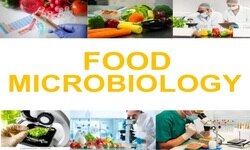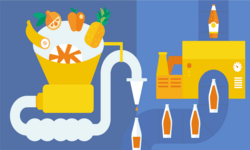Call for Abstract
Scientific Program
- Participant list of Academia of Food Pathogen conference
9th International Conference on Food Pathogen and Food Safety, will be organized around the theme “Microbiological and Chemical Aspects of Food Safety”
Food pathogen and Safety 2022 is comprised of keynote and speakers sessions on latest cutting edge research designed to offer comprehensive global discussions that address current issues in Food pathogen and Safety 2022
Submit your abstract to any of the mentioned tracks.
Register now for the conference by choosing an appropriate package suitable to you.
 Foodborne disease (as foodborne illness or food poisoning) is any illness that results from the consumption of contaminated food, contaminated with pathogenic bacteria, viruses, or parasites. Foodborne disease globally is still not under control and outbreaks can cause health and economic losses. There are 31 main foodborne pathogens causing diseases; the significant ones such as Salmonella nontyphoidal, Campylobacter, Listeria, and Shiga toxin-producing Escherichia coli are monitored by national authorities, and outbreaks are assessed in depth to assess trends and determine the steps necessary to combat future outbreaks.
Foodborne disease (as foodborne illness or food poisoning) is any illness that results from the consumption of contaminated food, contaminated with pathogenic bacteria, viruses, or parasites. Foodborne disease globally is still not under control and outbreaks can cause health and economic losses. There are 31 main foodborne pathogens causing diseases; the significant ones such as Salmonella nontyphoidal, Campylobacter, Listeria, and Shiga toxin-producing Escherichia coli are monitored by national authorities, and outbreaks are assessed in depth to assess trends and determine the steps necessary to combat future outbreaks.
- Emerging foodborne pathogens
- Causes and symptoms of foodborne illness
- Microbial Toxins, Virulence and Toxicity
- Bacteria and Enterotoxins
- Mycotoxins and alimentary mycotoxicoses
- Incubation period and Infectious dose
- Viruses and parasites
- Food poisoning
- Intoxications
- Epidemiology of foodborne illness
- Food Toxicology and Allergies
 Food microbiology is the study of the microorganisms which spoils and contaminates the food. The diseases caused by pathogens or the microorganism are mainly because of the food which is improperly cooked or stored. It cultivates microorganisms that have both useful and harmful impact on food quality and safety and may therefore be of concern to public health.
Food microbiology is the study of the microorganisms which spoils and contaminates the food. The diseases caused by pathogens or the microorganism are mainly because of the food which is improperly cooked or stored. It cultivates microorganisms that have both useful and harmful impact on food quality and safety and may therefore be of concern to public health.
- Microbiology of fermented foods and beverages
- Food mycology
- Predictive microbiology
- Microbial aspects of food spoilage and quality
- Industrial microbiology
- Nutritional availability in foods
- Applications of indicator organisms
- Factors affecting the growth of food micro-organisms
- Adoption of biofilms in food
- Food Spoilage and Preservation
- Vegetable (water) Processing
- Fermentation of Food Waste Streams
 Food is a basic need for people to survive. Food Science is a branch of science that deals with the investigation of the physical, chemical, and biological formation of food and food ingredients. The applications of food science innovate different branches like its selection, preservation, processing, packaging, distribution, and utilization of safe food. The main objective of food experts working towards people's life are huge and they also put a lot of effort into innovation by recent tools and procedures which are in the making of healthier food and ensuring a constant and plentiful supply of food ingredients.
Food is a basic need for people to survive. Food Science is a branch of science that deals with the investigation of the physical, chemical, and biological formation of food and food ingredients. The applications of food science innovate different branches like its selection, preservation, processing, packaging, distribution, and utilization of safe food. The main objective of food experts working towards people's life are huge and they also put a lot of effort into innovation by recent tools and procedures which are in the making of healthier food and ensuring a constant and plentiful supply of food ingredients.
- Novel Food Engineering Technologies
- Automation of Food Industry
- Chemical Reaction and Kinetics of food components
- Computer Applications in Food Technology
- Gene Technology and G.M Food crop
- Bioprocess Technology
- Consumer Acceptance
- Food Nanotechnology
- Industrial Applications of Food Technology
- Tools and Techniques in Food Technology
 Food preservation includes preventing the development of microorganisms and slowing the oxidation of fats that cause rancidity, resulting in a longer shelf life and a lower risk of food poisoning. Food protection is a major concern in the packaging industry because processed foods are easily contaminated, and a rise in contamination can rapidly spread illness. Food preservation must be combined with food production. Some preservation processes, such as the addition of food additives for preservation, cause diseases in humans. Many methods and techniques are now used in food processing and packaging to enhance food quality and shelf life, as well as to build a shield against oxygen, light, UV, and other contaminants. To enhance the Rheology, characteristics, and shelf life of foods, different ingredients and food designs are used to alternate the food products.
Food preservation includes preventing the development of microorganisms and slowing the oxidation of fats that cause rancidity, resulting in a longer shelf life and a lower risk of food poisoning. Food protection is a major concern in the packaging industry because processed foods are easily contaminated, and a rise in contamination can rapidly spread illness. Food preservation must be combined with food production. Some preservation processes, such as the addition of food additives for preservation, cause diseases in humans. Many methods and techniques are now used in food processing and packaging to enhance food quality and shelf life, as well as to build a shield against oxygen, light, UV, and other contaminants. To enhance the Rheology, characteristics, and shelf life of foods, different ingredients and food designs are used to alternate the food products.
- Food Preservation and Food Processing
- Food Design
- Food labelling
- Improvement of quality and shelf life
- Advanced methods of food preservation
- Novel food processing technologies
- Sustainable Packaging
- Self-Cooling, self-Heating Packaging
 Food Safety means to decrease the danger of people becoming sick from foodborne illness by proper handling, preparation, and storage of foods. Every food organization uses, processes, and sells food in several ways. The most aim of food safety is to avoid food contamination.
Food Safety means to decrease the danger of people becoming sick from foodborne illness by proper handling, preparation, and storage of foods. Every food organization uses, processes, and sells food in several ways. The most aim of food safety is to avoid food contamination.
An understanding of food safety is improved by defining two other concepts - toxicity and hazard. Toxicity is that the capacity of a substance to provide harm or injury of any kind under any conditions. Hazard is that the relative probability that harm or injury will result when a substance isn't utilized in a prescribed manner and quantity. Hazards are often physical, chemical, and biological causing harmful/adverse effects on the health of consumers.
- Food Security and Policy
- Food Quality Control and Quality Assurance
- Goods Manufacturing Practices (GMP)
- Goods Handling Practices (GHP)
- Hazard Analysis Critical Control Points (HACCP)
- Microbiological Aspects of Food Safety
- Risk Assessment and Risk Management
 The Food and beverages industry is all companies involved in processing raw food materials, packaging, and distributing them. This includes fresh, prepared foods as well as packaged foods, and alcoholic and non-alcoholic beverages. Beverage is any kind of liquid. ``Water, tea, coffee, milk, juice, beer and any kind of drinks item are listed in beverage items. The food and beverage service is part of the service-oriented hospitality sector.
The Food and beverages industry is all companies involved in processing raw food materials, packaging, and distributing them. This includes fresh, prepared foods as well as packaged foods, and alcoholic and non-alcoholic beverages. Beverage is any kind of liquid. ``Water, tea, coffee, milk, juice, beer and any kind of drinks item are listed in beverage items. The food and beverage service is part of the service-oriented hospitality sector.
- Pasteurization
- Modified atmosphere packaging
- Ultra-heat treatment, High-pressure processing
- Bioreactor design, instrumentation, control, and automation
- Fermented foods, seafood, and dairy products
- Food Intolerance and Allergies
- Genetically engineered foods
- Food production, processing, packaging, and internal control
 Food chemistry is the study of both biological and non-biological elements of food, chemical processes and their interactions. It is also related to organic chemistry as it deals with the identification and quantification of components of food, such as carbohydrates, lipids, proteins, water, vitamins, and dietary minerals.
Food chemistry is the study of both biological and non-biological elements of food, chemical processes and their interactions. It is also related to organic chemistry as it deals with the identification and quantification of components of food, such as carbohydrates, lipids, proteins, water, vitamins, and dietary minerals.
It also involves the research and synthesis of nutrients and preservatives, as well as other additives that can be used to preserve the quality of food or modify its colour, flavour, and taste. Food chemistry knowledge aids in the creation of proper food handling techniques as well as good manufacturing practises.
- Food Drug Analysis
- Food Additives
- Food Bio-Actives
- Food Components and Ingredients
- Food Adulteration and Fortification
- Food Flavouring and Coating
Food Science helps in the preparation of nourishment items from the raw materials of rural areas that are sufficient for human utilization. A Food Scientist has the ability to change over these craw materials into the protected, appealing nourishment items and drinks accessible on our grocery store racks. Nutrient Scientists continually look to enhance existing systems by which new items are created, prepared, bundled, put away, and transported.
- Clinical Nutrition
- Nutrition and Cancer
- Probiotics and Prebiotics
- Paediatric Nutrition
- Plant Nutrition
- Animal and Diary Nutrition
- Public Health Research
Food Science is a dynamic field to concentrate on that applies sciences, for example, Chemistry, Biochemistry, and Microbiology to find optimal approaches to enhance the taste, nourishment, and nature of the world's nourishment supply. Micro-organisms were used in industrial processes and thus useful in preserving and contaminating food even before their existence was known. The production of fermented beverages and vinegar, and the leavening of bread are all traditional processes and preserved by using enzymes that have come down to us from time immemorial. The discovery of micro-organisms with their multiplicity of highly specific biochemical activities has quickened a sustainable growth of industrial fermentation processes.
- Dairy Science and Technology
- Meat Science and Processing
- Wine Industry
- Sea Food Processing
- Cereal and Bakery Industry
- Vegetable and Fruit Industry
 National legal systems are a critical component of a successful food control system. The nourishment legislation has minimum quality requirements to ensure that the food supplied is unadulterated and not subjected to any deceptive activities intended to defraud the consumer. Sustenance legislation should cover the entire supply chain, from animal care arrangements to on-farm controls and early handling, all the way to final delivery and use by the consumer. Is a rational teaching that depicts coping with, preparing, and sustenance capability in ways that lead to foodborne disease. The tracks within this line of thinking are business and consumer well-being, followed by market and purchaser well-being.
National legal systems are a critical component of a successful food control system. The nourishment legislation has minimum quality requirements to ensure that the food supplied is unadulterated and not subjected to any deceptive activities intended to defraud the consumer. Sustenance legislation should cover the entire supply chain, from animal care arrangements to on-farm controls and early handling, all the way to final delivery and use by the consumer. Is a rational teaching that depicts coping with, preparing, and sustenance capability in ways that lead to foodborne disease. The tracks within this line of thinking are business and consumer well-being, followed by market and purchaser well-being.
 A balanced and nutritious diet is the connection between food and human health. The dietician assisted participants in making dietary changes, such as consuming less junk food and more nutrient-dense foods like fruits, vegetables, fish, and legumes. People are now realising that there is a biochemical and physical connection between what we eat, how it makes us feel, and our mental wellbeing, in addition to a psychological one. When it comes to common diseases like diabetes, cancer, high blood pressure, and heart disease, there's a lot of debate about how nutrition plays a role and how you can lower the risk by consuming certain foods and adopting certain diet habits. The same can be said about mental health.
A balanced and nutritious diet is the connection between food and human health. The dietician assisted participants in making dietary changes, such as consuming less junk food and more nutrient-dense foods like fruits, vegetables, fish, and legumes. People are now realising that there is a biochemical and physical connection between what we eat, how it makes us feel, and our mental wellbeing, in addition to a psychological one. When it comes to common diseases like diabetes, cancer, high blood pressure, and heart disease, there's a lot of debate about how nutrition plays a role and how you can lower the risk by consuming certain foods and adopting certain diet habits. The same can be said about mental health.
- Food for Depression, anxiety and stress
- Effect of food on hormones
- Food Perception
- Health Hazards
- Junk Foods
 The food industry is a complex, global network of diverse businesses that supplies most of the food consumed by the world's population. The term food industries covers a series of industrial activities directed at the production, distribution, processing, conversion, preparation, preservation, transport, certification and packaging of foodstuffs. The food industry today has become highly diversified, with manufacturing ranging from small, traditional, family-run activities that are highly labour-intensive, to large, capital-intensive and highly mechanized industrial processes. Many food industries depend almost entirely on local agriculture, produce, or fishing.
The food industry is a complex, global network of diverse businesses that supplies most of the food consumed by the world's population. The term food industries covers a series of industrial activities directed at the production, distribution, processing, conversion, preparation, preservation, transport, certification and packaging of foodstuffs. The food industry today has become highly diversified, with manufacturing ranging from small, traditional, family-run activities that are highly labour-intensive, to large, capital-intensive and highly mechanized industrial processes. Many food industries depend almost entirely on local agriculture, produce, or fishing.
- Food Innovation
- Beverage Industry
- Meat and Poultry Food
- Refrigerated and Frozen Food
- Grocery
- Food Service

